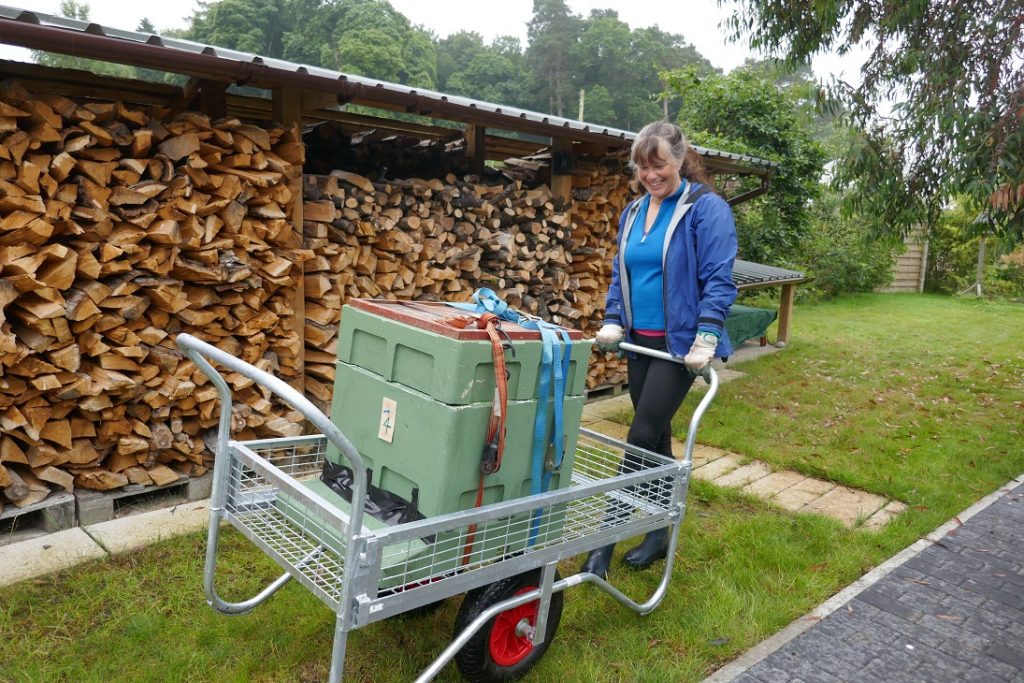
Many hobby beekeepers have never had to move bees before and it can feel like quite a daunting task the first time you do it. If you consider the risks and everything that can potentially go wrong and if you minimise them then it usually goes very smoothly. Planning ahead is key to success and organising a team of helpers improves the chances of a smooth transit and reduces the risk to bees, beekeeper and the public road users.
Firstly, the bees must be healthy and disease free if they are to be moved anywhere, unless of course it is to your isolated quarantine/hospital apiary far away from healthy colonies.
The biggest risk to the colony is overheating, even on a cool day. This is because as soon as honey bees are confined by having the front entrance blocked they panic and struggle to get out which generates more heat. They don’t like vibrations and you cannot take them anywhere without causing some but this also increases stress. A colony can suffocate in a very short time without adequate ventilation. If you are traveling far then the risk increases but it can be mitigated by giving plenty space such as placing an empty shallow box on top of the super, or, if there is no super, placing it on top of the brood box.
By closing the entrance after the colony has finished flying for the day, the bees can be transported in the cool of the evening. Early morning works well too in some situations.
Ventilation.
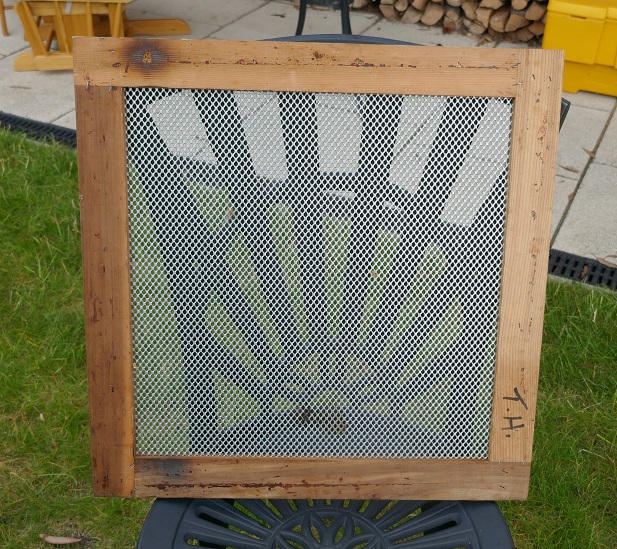
A travel screen replaces the crown board/cover board and roof for the journey allowing for much better ventilation. If you have an open mesh floor it is best if you can raise the floor up slightly so that it is not flush with the bed of your truck or car boot/trunk and air can circulate.
Positioning Hives in Transit.
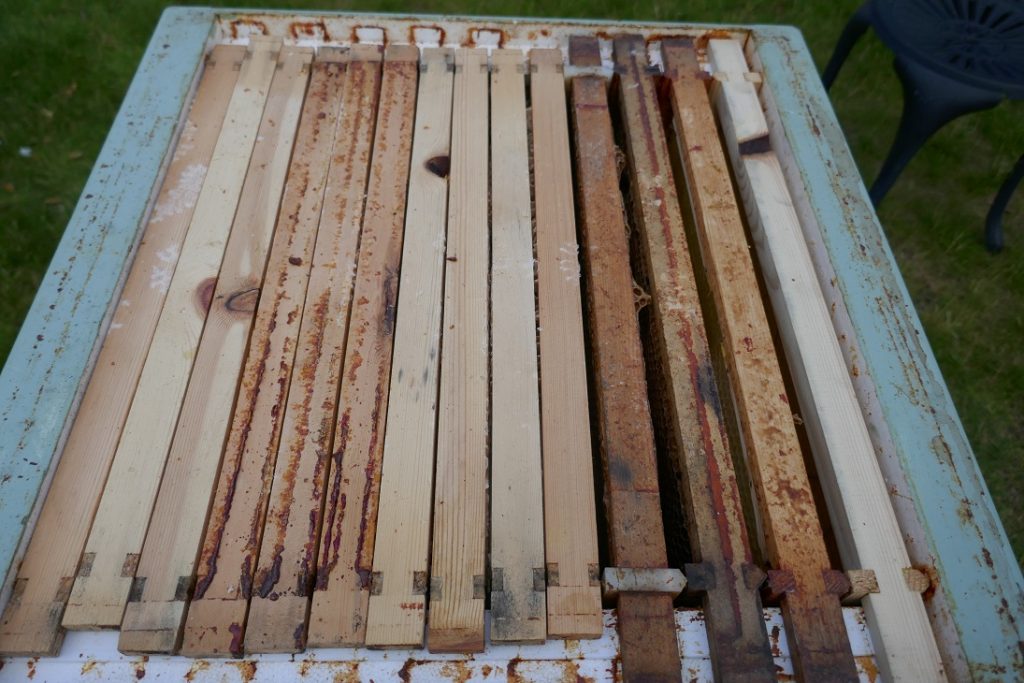
The hives need to be placed with the frames aligned longtidudinally and top bars pointing in the direction of travel. This is because if the vehicle has to make a sudden stop the frames will not concertina together crushing bees if there are any gaps between them.
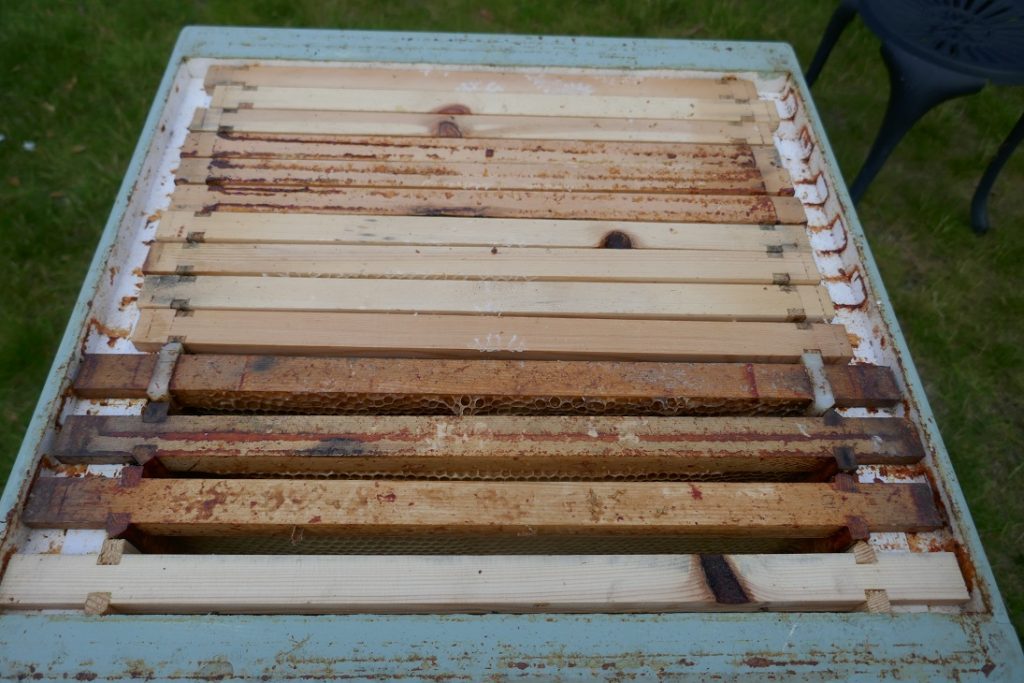
In this lateral position the frames might concertina together during a sudden stop crushing perhaps the precious queen.
Thirst.
Bees can get very thirsty on a journey and having a water spray with fresh water is essential on a journey longer than half an hour. You can spray a little through the travel screen stopping a few times on a long journey. However, don’t overdo it and a gentle misting is good. If you douse them in water they overheat trying to dry off and warm up again in the process.
Securing Hives.
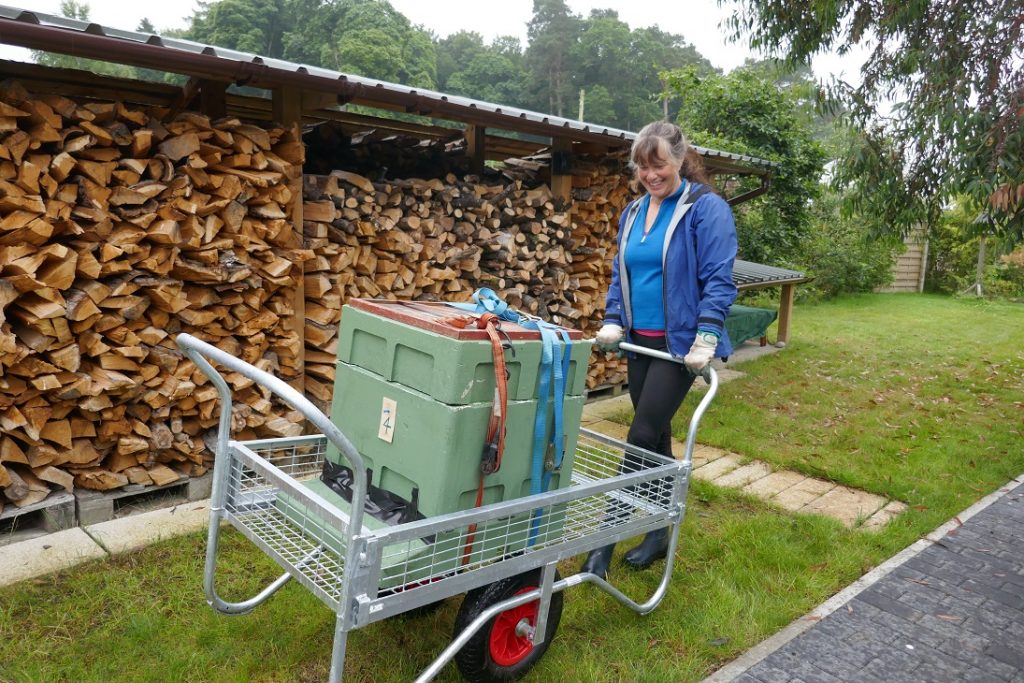
Two straps firmly ratcheted onto the sides of the hive holds the boxes together safely and the hives may be lifted holding the straps. Ideally the entrance is blocked with wire mesh but I’ve used foam sponge and Gorilla tape to block this entrance.
Lifting.
There is always a risk to the beekeeper of back damage when moving hives so I have transferred the colonies into poly hives and used the trolley to move from apiary to car. I’ve enlisted the help of one of my stalwart bee buddies (see above) to help with lifting and logistics. Jane starts her day really early so is happy to help move bees first thing in the morning.
Every beekeeper needs to work out the best way to reduce risk for themselves.
Public Safety.
Accidents happen and we have all read about the big trucks in the US spilling a load of hives on the highway. A hapless hobbyist near here lost a couple of colonies off the back of his truck moving to the OSR a few years ago. I don’t drive in my beesuit but I have it handy, and a spare one should I need help on the journey. If bees do escape from the hive they usually gravitate to the window rather than fly round in a frenzy over your head. Often some are underneath the hive when you shut the entrance so they will appear in your vehicle during the journey if you haven’t checked and removed them.
I heard about a misinformed new beekeeper, not too far from Nairnshire, who was recently advised that you don’t need to shut bees in as they don’t come out of the hive on the journey. By the time the beekeeper reached her destination, having stopped briefly en route, the car was black with bees covering the windows.
My beekeeping hero, R.O.B. Manley, tells us in Beekeeping in Britain of a similar story. He describes how in America, in the middle of last century, migratory beekeepers tried moving bees in the middle of the night with open entrances so that the bees could cluster out on the fronts of the hives if they wanted to. Over here in the UK at that time, Mr Gale, one of the first commercial bee farmers, tried it. Manley reports, “Gale tried it on once; but I don’t think that he will do it anymore”. Apparently the bees travelled alright but as soon as they reached their destination and daylight came the trouble began because the moment the vehicle stopped the bees all came out to see what was going on, and Manley says, “the confusion was, I gather, rather bad”. As long as the vehicle is in motion the bees will stay put, even in daylight, but the moment the vehicle stops the bees fly out which makes that practice one to be avoided by the hobbyist.
New Out Apiary.
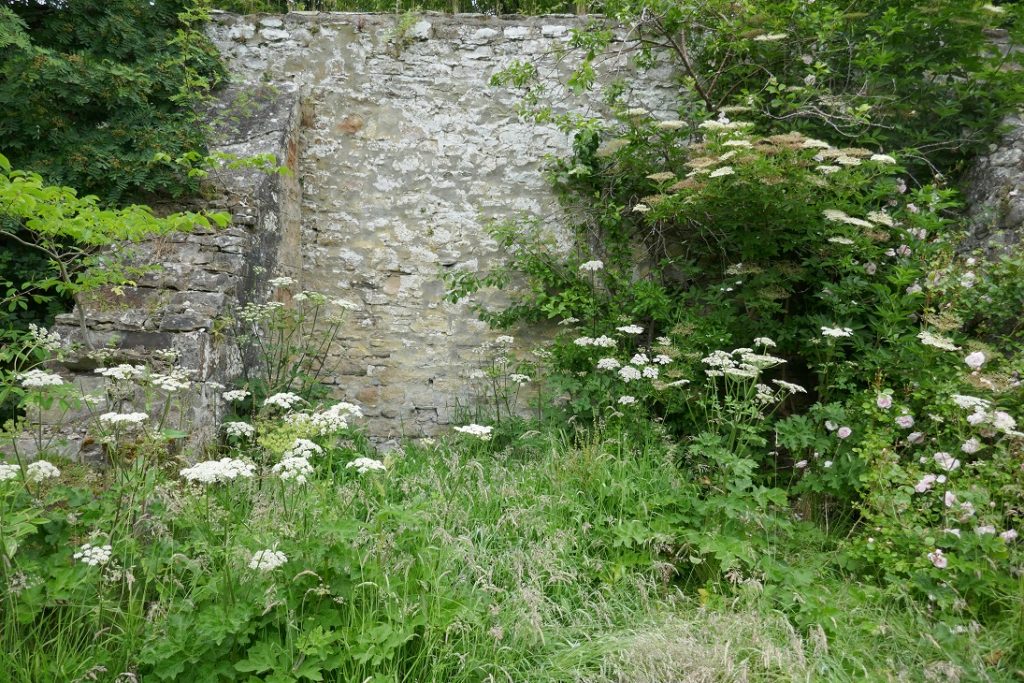
I’ve been needing to find an out apiary for a while because there are too many colonies in my garden and, as luck would have it, out of the blue I received a phone call from Sally offering a wonderful site in return for helping her manage two colonies. Sally lives on lush land near the River Nairn and raises pedigree Highland ponies on 40 acres of rich unspoiled meadow land around 4 miles from our house.
I went over last week with Cynthia to inspect Sally’s bees and clear the vegetation where I would site two colonies.

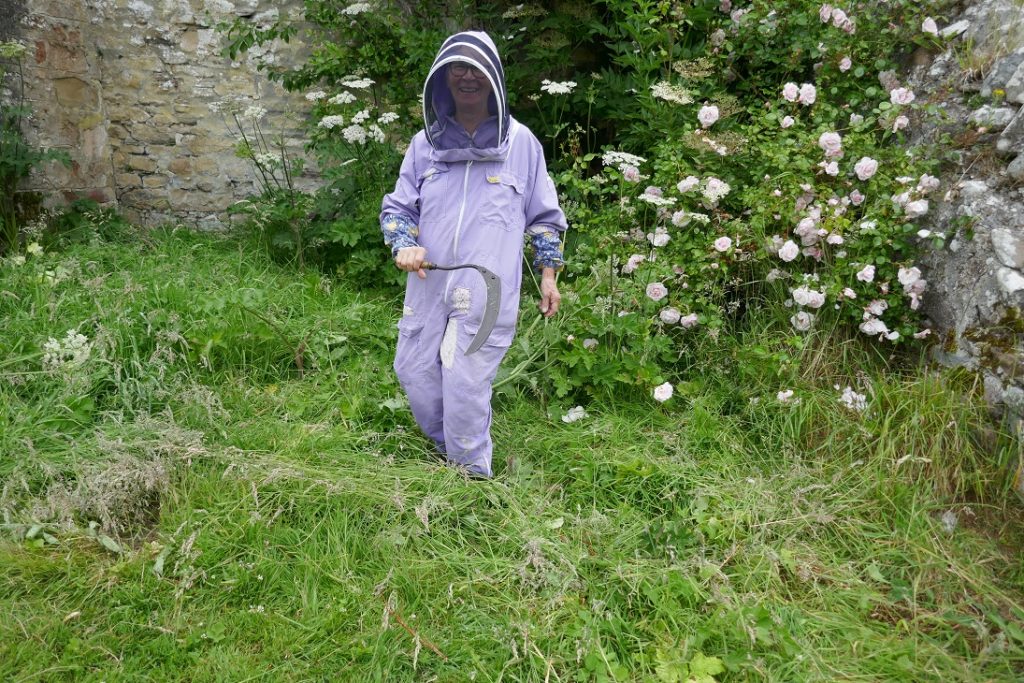
I’m laughing because Cynthia says I look like the grim reaper. I’m pretty certain that the grim reaper has a longer and more efficient scythe. I’ve searched high and low to no avail for my longer scythe given by Tearlich and Derek in exchange for a colony of bees several years ago. So, I use instead the one I bought at Auldearn Antiques (bought because it reminded me of the scythes used on the farm in the ’50s for small jobs). I check on Youtube how to sharpen it and get a fine blade that works well enough. I like it that scything doesn’t disturb the bees. I’ve never used a strimmer before but I can see the advantage. It’s a hot day and we wear our beesuits because it’s humid and sultry and Sally’s bees objected to the sugar roll tests. We should have prepared the site first but hindsight is a wonderful thing.
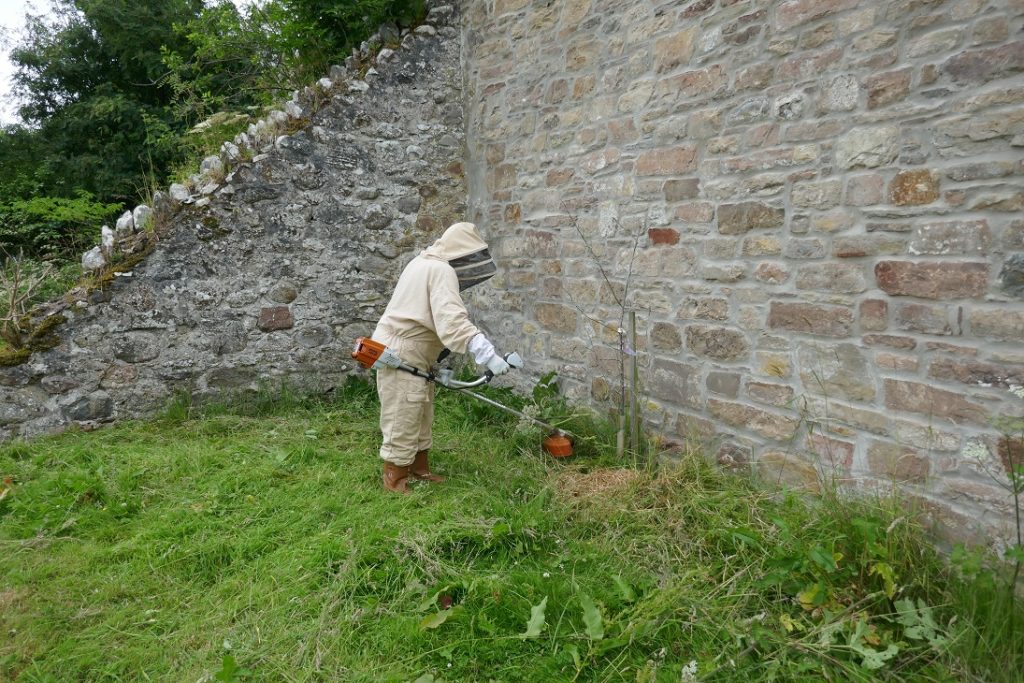
Cynthia borrows Sally’s strimmer and finishes the job.
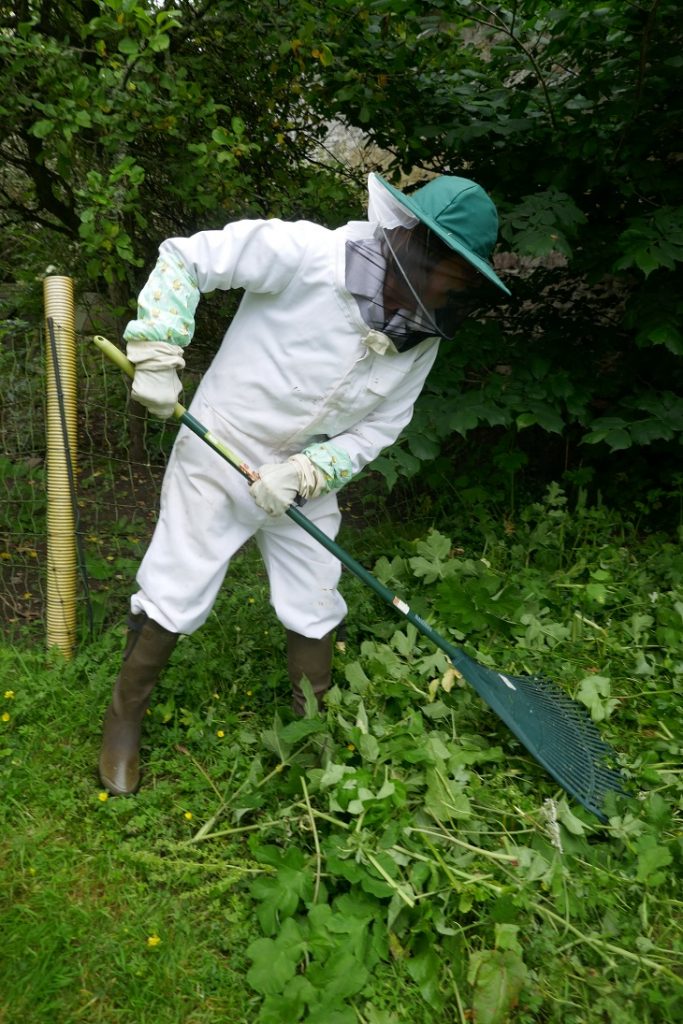
Moving day.
I set the alarm for 6am and shut the bees in then rather than the night before because they need to ventilate overnight and process nectar. When Jane arrives we lift the concrete slabs into the boot of her car protecting the paintwork by laying them on a bit sheet of sturdy foam and pulling them further in on the foam to protect our backs.
The previous evening when I was levering up the slabs and trolleying them along to the car I disturbed a mother woodmouse and her nest of babies. The evening air was still and I could hear her terrified breaths as she looked at me in wide eyed horror. I couldn’t return the slab without risking squashing the little family so I quickly found a wooden board to cover them. Afraid that she might abandoned her babies, I’ve been setting down peanuts close to an entrance and they disappear so I think that all is well and I feel better about it.
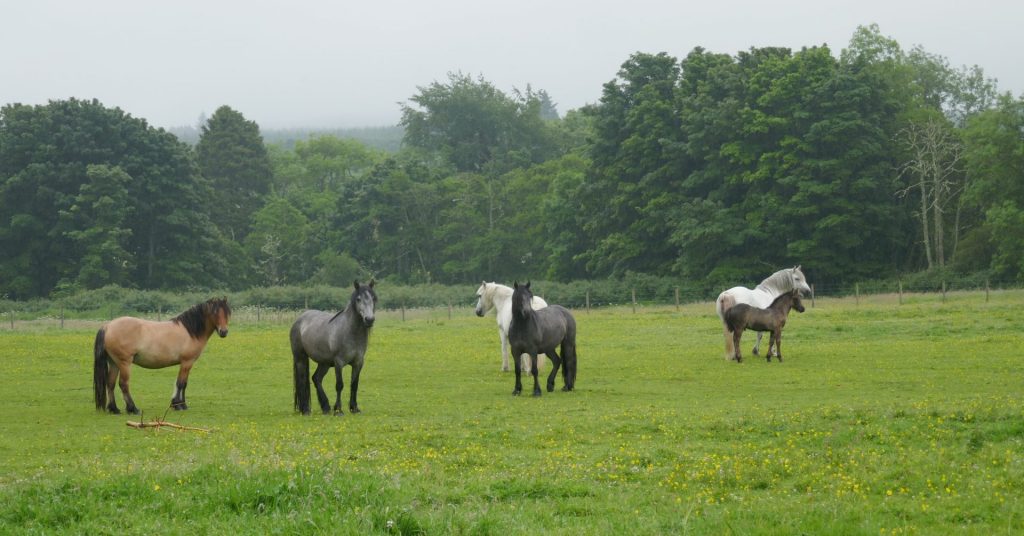
It all goes to clockwork. We arrive at the gate to the meadow at 09:01 (one minute late) and Sally is waiting in the drizzling rain to open the gate and direct us over several fields to the walled garden. We have a welcoming committe of ponies who come over to check us out. A flock of guinea fowl flies up out the meadow in a flurry on our approach.
Another mutual beekeeping friend, TJ Baird, is waiting at the apiary site with a trolley and spade and he digs in the slabs where I want them.
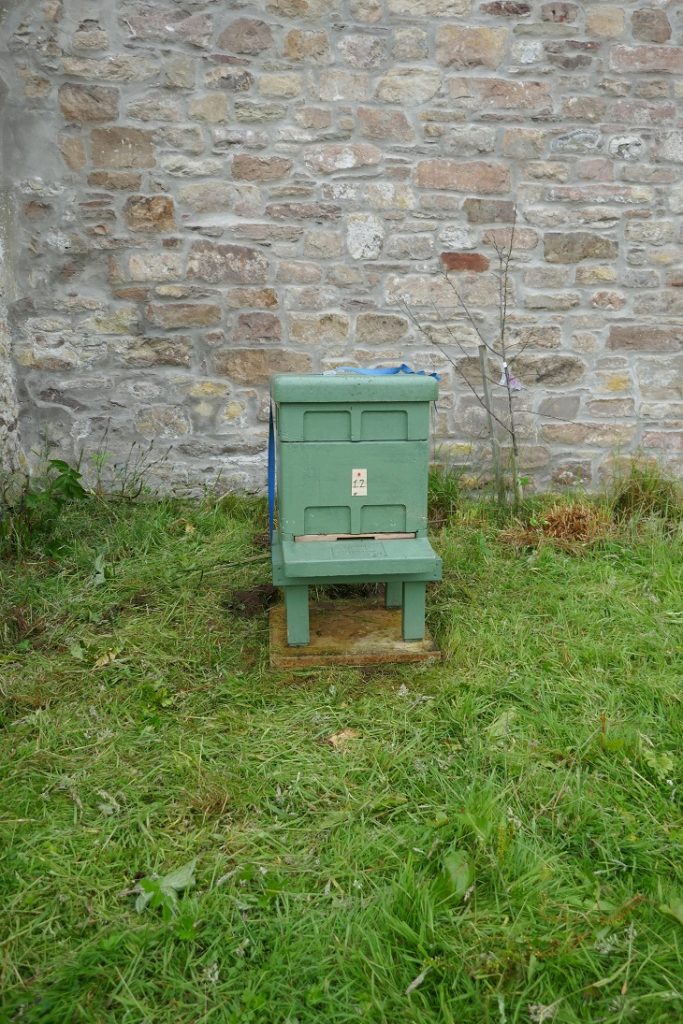
Moving Bumble Bees.
I was just getting into my stride earlier in the week starting this blog when I got an urgent call for help relocating bumble bees. Paul is the first on my doorstep when I need help so I go straight over.
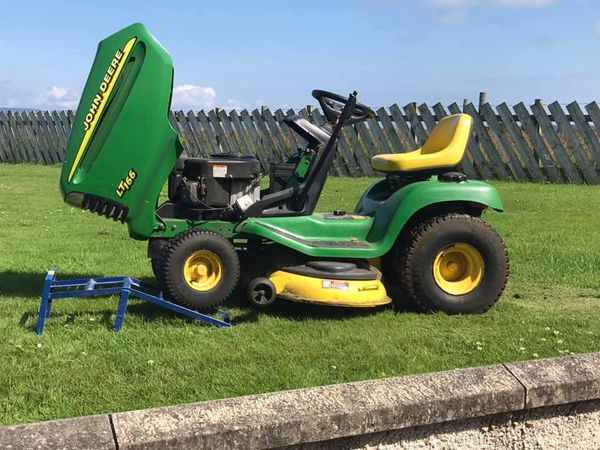
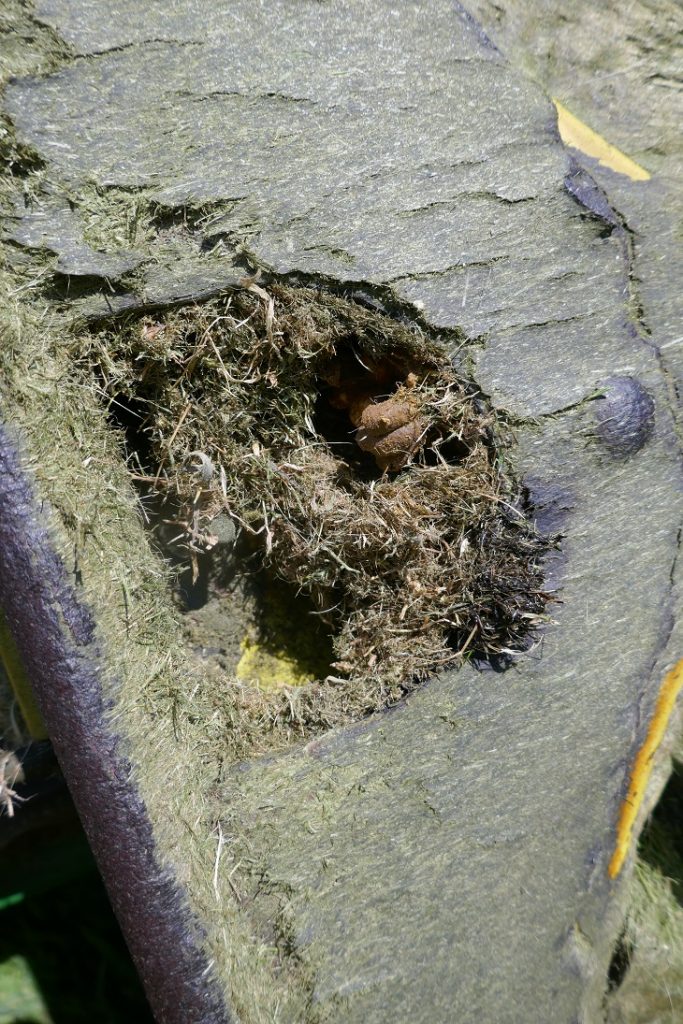
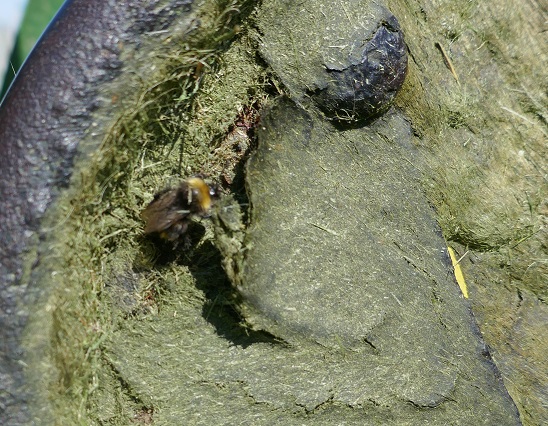
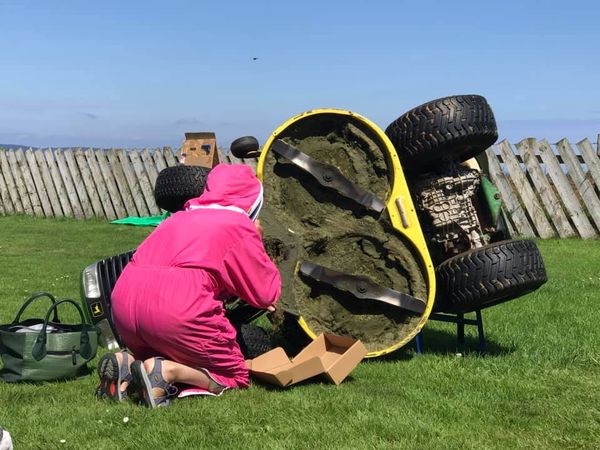
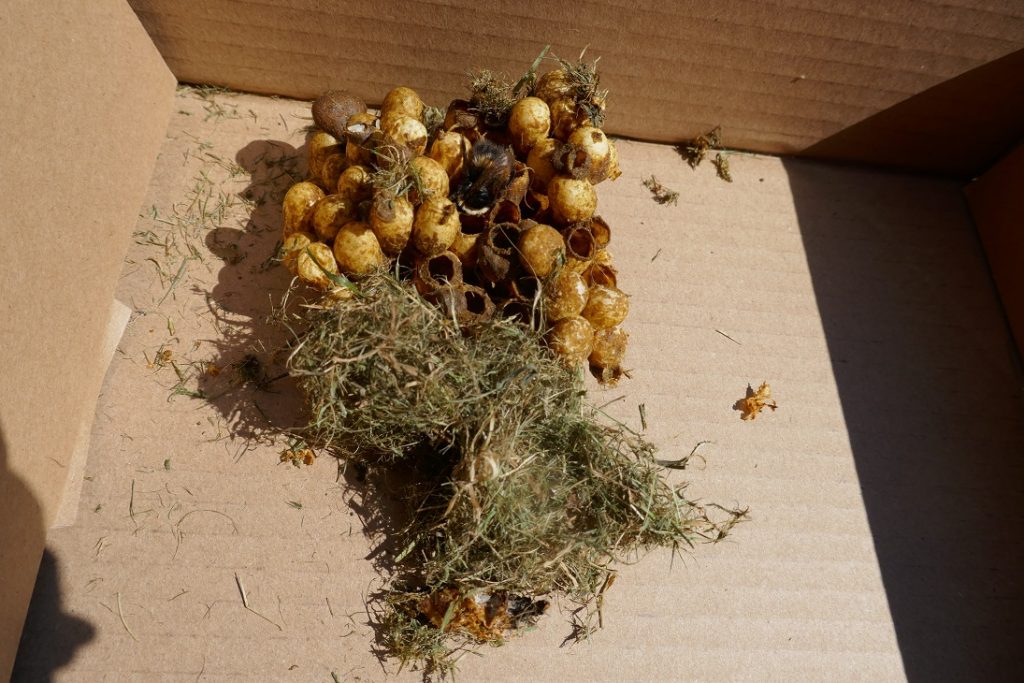
I borrow Tash’s kitchen knife and carefully remove the nest from inside the mower where the accumulation of dried grass clippings makes an ideal nest. I wear a beesuit from previous experience with agitated bumble bees but they have mostly left the nest. This large bee with its head in a cell looks like a queen.
What happened next took some effort but I had to give it a go. When I went into the shed where the mower is stored I discovered a few larger bees burrowing into dried grass on the floor and a lot flying in and out of the shed. I placed them in a lidded box and started a new game of skill! It was pretty warm but I danced around catching flying bees in a tiny children’s fishing net and put them into a lidded box. When the numbers flying in and out had reduced I rearranged the nest under a rose bush with the plastic box over the top and an entrance made using a stone to prop it up. I covered the clear box with the cardboard one to shade it and hoped for the best. I will get a report soon on what happened next and if at least some of the colony has been saved. I suspect that the flying bumble bees returned to the shed but we gave them the best chance.
We found the small hole on the mower that they were entering to reach the nest and blocked it off. Paul is going to hose out the mower after each use now and keep it free of grass clippings.
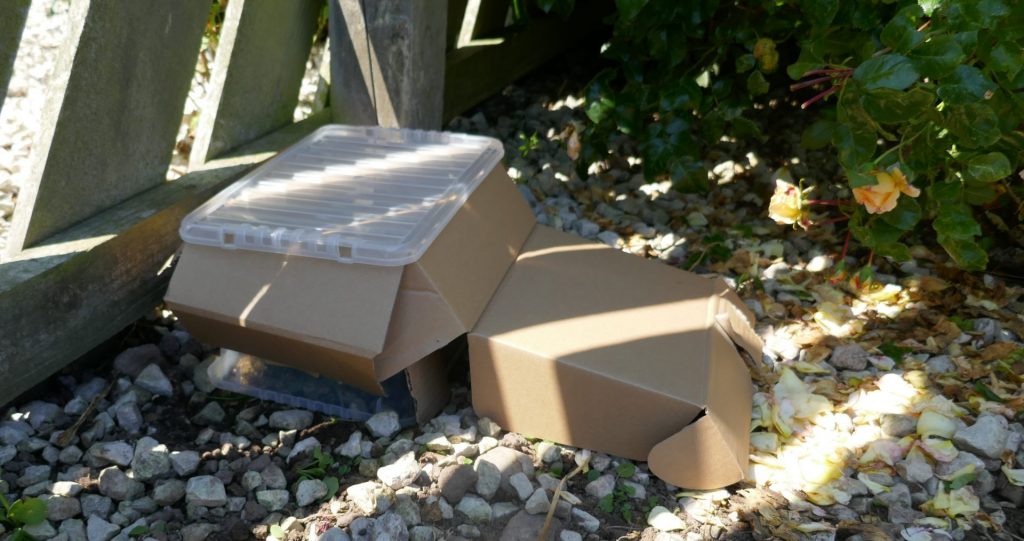
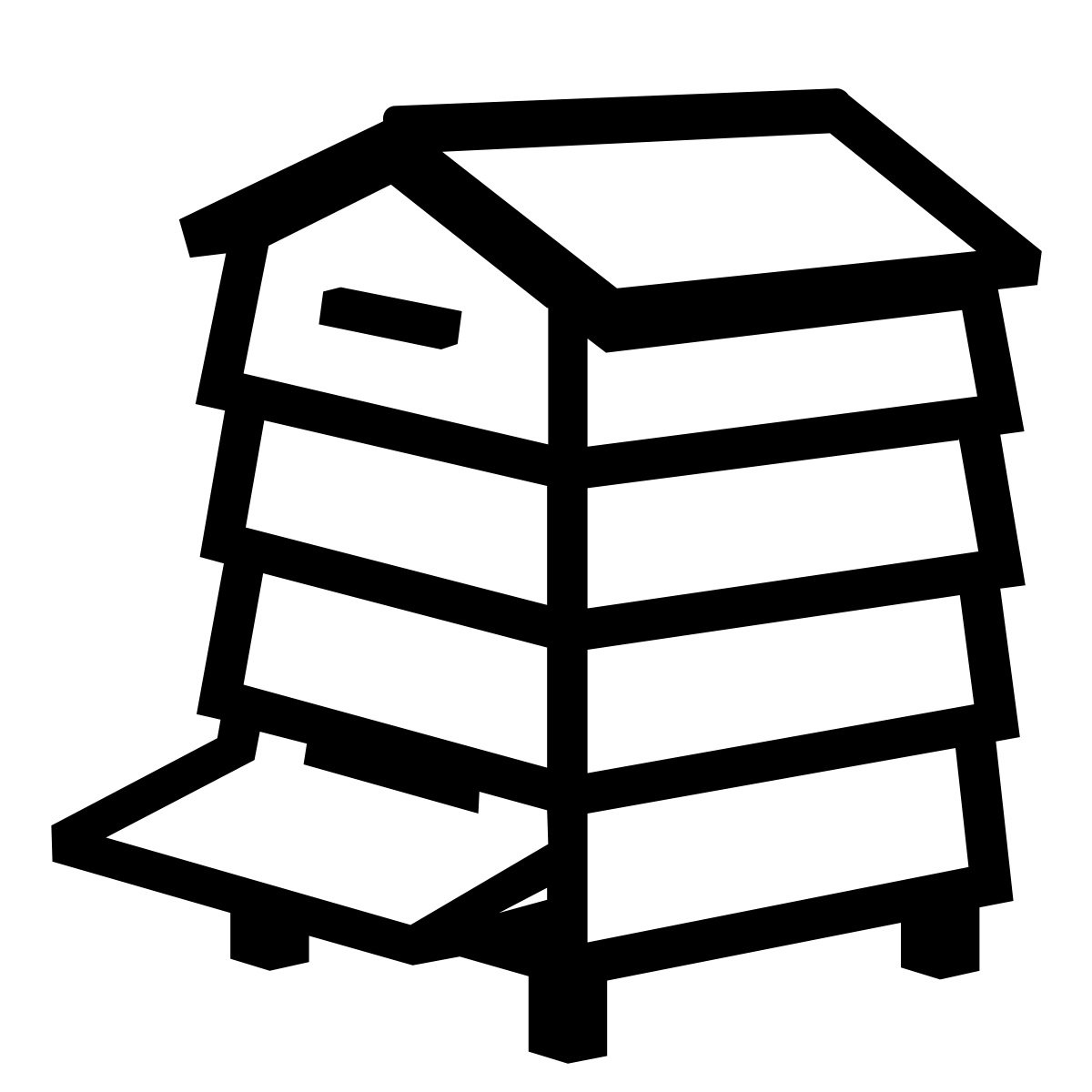
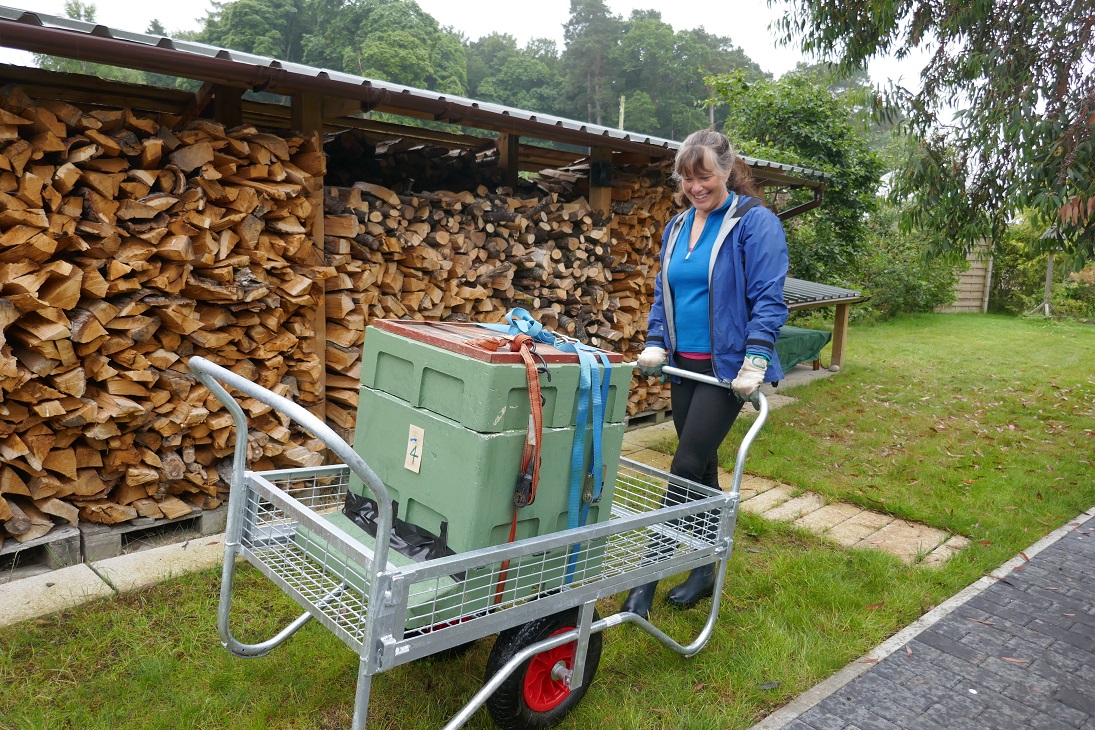
Great article Ann.
Thanks, Fred. You could add these to your repertoire of useful beekeeping equipment construction.
This is so helpful.
Good, Sally. Thank you for commenting.
T ravelling screens are not needed often by hobbyists but vital for a move as Anne says.
They are something that associations could make and lend out when needed.
Thank you for commenting, Robin. Where I live in the Scottish Highlands many beekeepers take bees to the heather so are used to traveling screens but as you say they are easy to make and associations could promote their use.
Oh Dear. Perhaps this is the moment to confess my latest crime against apian life. On the up-side, it’s all Ann Chilcott’s fault for keeping this from me until today.
Over our stuttering Spring, I lost both my colonies, which I had nurtured so well over the long, cold Winter. With the lovely, warm false Spring we had, they had begun to expand, but when Spring suddenly turned to Winter again (it’s Grantown, so Summer’s much the same) they went back into a cluster – excellent fodder for disease – and that’s when I lost my two very promising colonies. But I digress…
I ordered a nuc from a commercial supplier – good grief they’re expensive just now and, of course, nuc-making was relatively late this year because of the strange weather conditions. However, my beekeeping friend in Aviemore knew of my beeless plight so when one of her hives swarmed, she gave me a call. Generous to the environment (or, in this case, a fellow beekeeper), she habitually allows her colonies to swarm naturally. The swarm had conveniently settled in a low cherry tree in her garden, only a few yards from the hive. But I digress…
Up to Aviemore with my swarm-collecting kit, and there they are, eminently collectable. That’s a pretty big swarm, I thought. So, my friend holds the skep underneath and I nip up a ladder. That’s a pretty big swarm, I thought. I would have smacked the branch with my crowbar, but they weren’t on a branch; they were at the top of the main trunk, where it divided off into the main boughs of the tree, so my bee-brush was the thing. Easy-peasy. Brushed most of the swarm down into the skep in a few sweeps. Lots of others flying off, of course. There was less wood and more bee under there than I’d thought. That’s a pretty… you get the point.
I have a nuc at the ready for transport back to Grantown and we pour much of the swarm directly from the skep into the nuc. My friend sees her brightly-marked Queen in the bunch and says goodbye to her. Perfect. We are chuffed. Lid on the nuc and skep on its side at the entrance. The rest of the skep start to march into the nuc. That’s a…
So, we stand around as the flying bees come back and march into the nuc with their mates. That’s…
With ninety-nine per cent of the swarm in the nuc, we close the door and the stragglers will have to go back to their original hive, only a few yards away. I pick up the nuc. That’s a pretty heavy nuc… and put it in the back of my car, shooing away a few followers. In anticipation of (some of) Ann’s advice, I have a strap around the nuc and it’s well-secured to the back floor of my car… Satisfied at our rather sweaty achievement – it’s a beautiful day – we have a cool glass of water to celebrate.
It usually takes maybe twenty minutes to drive from Aviemore to Grantown, but I take it easy to minimise the bumping around and avoid the potential disaster of a bump of the other kind. The bees are furious anyway – ungrateful little… Anyway, more like twenty-five to thirty minutes. No matter, there’s no hurry, all is well.
Arrive home and take out the nuc. That’s a heavy… It’s also a very quiet one. My ears start to buzz in exactly the way that the nuc isn’t. With a heavy heart, though lighter than the nuc, I open up. Guess what. Oh, you have already. Dead. Cooked. I could have cried; certainly, my eyes watered. I took out the few frames I’d put in for the swarm to hang onto, but they weren’t on the frames, they were in a big pile on the bottom of the nuc – a BIG pile. Even without the frames, the nuc was more than half full (one of the Maisiemore ones). No wonder it had been heavy. I was devastated.
It wasn’t the loss of the bees. I was no worse off than this morning, and if they’d settled somewhere else I’d never even have got to know them, however briefly. And it was no loss to my friend, who had every intention of letting them fly the nest had I not been a friend in need. It was the loss of life and in particular bee-life, to which I am even more than usually attached. I am a mass murderer.
So when Ann Chilcott tells you what to do, bloody well do it. And when Ann Chilcot tells us what to do, could she please do it a week earlier.
Hereby ends my confession, for I have sinned. And I’m not even a Christian.
Ashamedly yours, Avery Mathers
(That’s a…)
That was a horrible experience, Avery, but you will not be the first that this has happened to. Sometimes people collecting large swarms in skeps suffocate the bees taking them home. One of the things you can do with a poly nuc is get some plastic mesh from a garden centre and cut out enough to cover the top of the nuc. It is easy to pin it down safely and the roof stays off during the journey.
Thank you for sharing this with the readers so they can learn from your experiences.
Onwards and upwards.
Ann
I will second Avery M’s sterling endorsement of the recommendations of this week’s edition of The Beelistener.
45 years ago, I needed to move two colonies about 50 miles, and to do so I rented a U-Haul trailer of the sort that closes up tightly (for security). It was a hot day in July, and the hives had been screened for about 12 hours (they were being moved off an island) even before I slid them into the trailer. Then I made the 50 mile drive to their new apiary. When I got there, I could hear lots of buzzing inside the hives, so it was clear that they were still alive. Good!!! But when I removed the entrance screens, both colonies absconded. All the bees in both hives flooded out and flew away, abandoning their combs, their brood, and their food. Clearly, they judged where they were living was utterly unacceptable.
I missed the bees, of course, but I was also a bit delighted to have seen something that one rarely sees: an absconding event! And this was pretty cool, so to speak.
Thank you for your comments this week, Tom, and for sharing the absconding story. All these experiences are helpful for us in reducing transport risks.
I have just discovered that bee supply companies in the UK now supply travel screens for some nuclei such as Maisemore.
In your situation on Appledore Island, I suppose you had to have them shut in for a while to fit in with when they stopped flying for the day, and when the ferry left the island.
Yes, that is right. I had shut in the bees on the evening before I left the island. They were also shut in much of the next day, for the ferry did not leave the island until noon, and it took a few more hours to get to shore, offload my gear, and take the colonies to their new location in a town outside Boston. So, they were enclosed in the screened hives for about 18 hours. I had installed a moving screen on top of each hive, had put a screen over each one’s entrance, so they had decent ventilation. I had also poured water into each hive, through the top screen. I think thecolonies would not have overheated if I had not needed to put them inside a closed van/trailer for the 1 hour drive from Portsmouth, New Hampshire to Concord, Massachusetts. Ever since, I have moved colonies long-distances using a pickup truck, so their hives stay well ventilated. Live and learn.